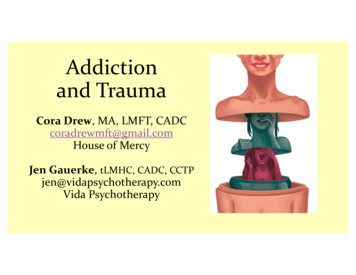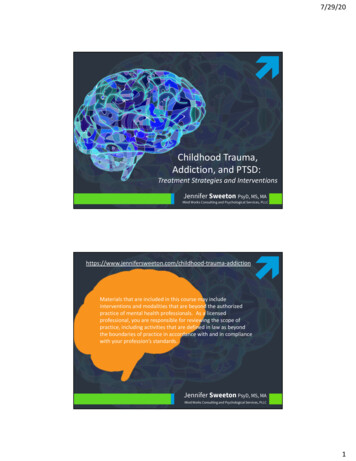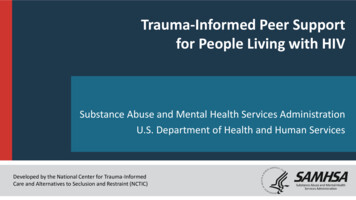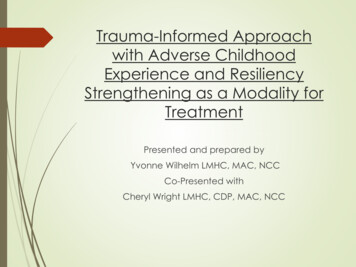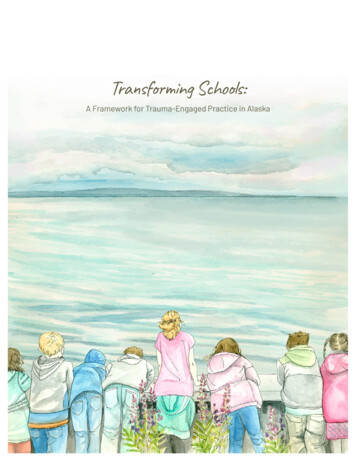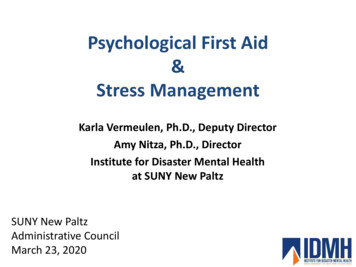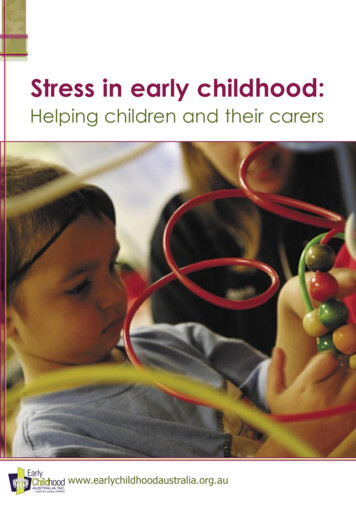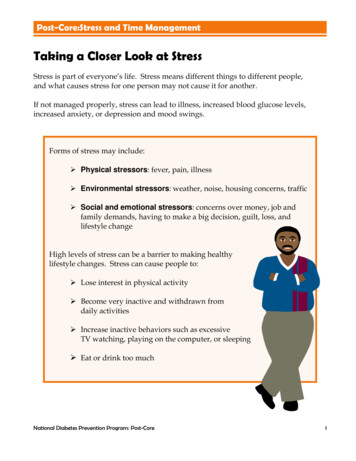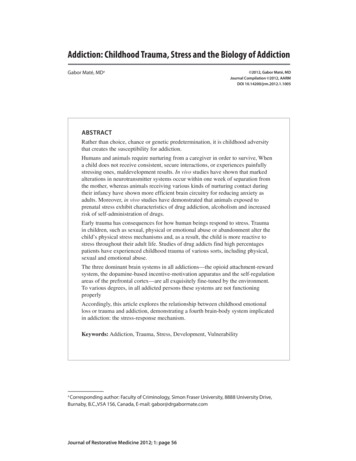
Transcription
Addiction: Childhood Trauma, Stress and the Biology of AddictionGabor Maté, MDa 2012, Gabor Maté, MDJournal Compilation 2012, AARMDOI 10.14200/jrm.2012.1.1005ABSTRACTRather than choice, chance or genetic predetermination, it is childhood adversitythat creates the susceptibility for addiction.Humans and animals require nurturing from a caregiver in order to survive, Whena child does not receive consistent, secure interactions, or experiences painfullystressing ones, maldevelopment results. In vivo studies have shown that markedalterations in neurotransmitter systems occur within one week of separation fromthe mother, whereas animals receiving various kinds of nurturing contact duringtheir infancy have shown more efficient brain circuitry for reducing anxiety asadults. Moreover, in vivo studies have demonstrated that animals exposed toprenatal stress exhibit characteristics of drug addiction, alcoholism and increasedrisk of self-administration of drugs.Early trauma has consequences for how human beings respond to stress. Traumain children, such as sexual, physical or emotional abuse or abandonment alter thechild’s physical stress mechanisms and, as a result, the child is more reactive tostress throughout their adult life. Studies of drug addicts find high percentagespatients have experienced childhood trauma of various sorts, including physical,sexual and emotional abuse.The three dominant brain systems in all addictions—the opioid attachment-rewardsystem, the dopamine-based incentive-motivation apparatus and the self-regulationareas of the prefrontal cortex—are all exquisitely fine-tuned by the environment.To various degrees, in all addicted persons these systems are not functioningproperlyAccordingly, this article explores the relationship between childhood emotionalloss or trauma and addiction, demonstrating a fourth brain-body system implicatedin addiction: the stress-response mechanism.Keywords: Addiction, Trauma, Stress, Development, VulnerabilityCorresponding author: Faculty of Criminology, Simon Fraser University, 8888 University Drive,Burnaby, B.C.,V5A 1S6, Canada, E-mail: gabor@drgabormate.comaJournal of Restorative Medicine 2012; 1: page 56
Addiction: Childhood Trauma, Stress and the Biology of AddictionINTRODUCTIONAccording to the National Survey on Drug Use andHealth (NSDUH), it is estimated that 22.6 millionAmericans have a substance dependency or abuseproblem.1 Alcohol is reported to be the most widelyused intoxicant in the United States, with increasedrates seen during teenage years. Marijuana is themost abused drug in the United States, followedby prescription painkillers, with other drugs usedto a lesser extent. Substance dependence or abusereportedly peaks in adults aged 18 to 25.1Various stressors experienced in early childhoodhave been shown to alter the development andfunctioning of different areas of the brain. Thepresent review summarizes the impact of earlyenvironmental stress and trauma as risk factors foraddiction.THE ROLE OF NURTURING ANDRELATIONSHIP ATTACHMENTS IN THEDEVELOPING CHILDHappy, attuned emotional interactions with parentsstimulate a release of natural opioids in an infant’sbrain.2 This endorphin surge promotes the attachment relationship and the further developmentof the child’s opioid and dopamine circuitry.2 Incontrast, stress reduces the numbers of both opiateand dopamine receptors.2 Healthy growth of thesecrucial systems—responsible for such essentialdrives as love, connection, pain relief, pleasure,incentive and motivation—depends, therefore, onthe quality of the attachment relationship.3,4 Whencircumstances do not allow the infant and youngchild to experience consistently secure interactionsor, worse, exposure to many painfully stressingones, maldevelopment often results.5Dopamine levels in a baby’s brain fluctuate, depending on the presence or absence of the parent.6A study in four-month-old monkeys showed thatmajor alterations of dopamine and other neurotransmitter systems occurred after only six daysof separation from their mothers. “Loss of animportant attachment appears to lead to less of animportant neurotransmitter in the brain. Once thesecircuits stop functioning normally, it becomes moreand more difficult to activate the mind.”7In vivo studies have demonstrated that social- emotional stimulation is necessary for the growth ofthe nerve endings that release dopamine and forthe growth of receptors to which dopamine needsto bind in order to do its work.8Adult rats and micekept in long-term isolation have a reduced numberof dopamine receptors in the midbrain incentivecircuits and, notably, in the frontal areas implicatedin addiction.9 Rats separated from their mothersat an early stage display permanent disruptionof the dopamine incentive-motivation system intheir midbrains. Abnormalities in this system playa key role in the onset of addiction and craving.Predictably, in adulthood these maternally deprivedanimals exhibit a greater propensity to self-administer cocaine.10 In another study, rat pups deprivedof their mother’s presence for only one hour a dayduring their first week of life grew up to be muchmore eager than their peers to take cocaine on theirown demonstrating that extreme deprivation is notrequired for the occurrence of this behaviour. 11 Thepresence of consistent parental contact in infancy isone factor in the normal development of the brain’sneurotransmitter systems; the absence of it makesthe child more vulnerable to “needing” drugs ofabuse later in life to supplement what their brainis lacking. Another key factor is the quality of thecontact the parent provides, which in large part, isdependent on the parent’s mood and stress level.All mammalian mothers—and many human fathers,as well—give their infants sensory stimulation thathas long-term positive effects on their offspring’sbrain chemistry.12 Such sensory stimulation isnecessary for the human infant’s healthy biologicaldevelopment. Premature babies who have to live inincubators for weeks or months have faster braingrowth if they are stroked for just ten minutes a day.Humans hold and cuddle and stroke; rats lick as aform of nurturing. A study found that rats whosemothers had given them more licking and otherkinds of nurturing contact during their infancy had,as adults, more efficient brain circuitry for reducing anxiety.13 They also had more receptors on theirnerve cells for benzodiazepines, natural tranquillizing chemicals found in the brain.13Journal of Restorative Medicine 2012; 1: page 57
Addiction: Childhood Trauma, Stress and the Biology of AddictionIn more recent experiments, the infants of motherswho were not naturally as “affectionate” were transferred to the more nurturing mothers, they grew tobe adults with more efficient brain apparatus forreducing anxiety, suggesting that these differencesare not genetic, but rather are environmental.6Parental nurturing determines the levels of otherkey brain chemicals, too—including serotonin, themood messenger enhanced by antidepressants likeFluoxetine (Prozac, Eli Lily, Indiana). Peer-rearedmonkeys, separated from their mothers, have lowerlifelong levels of serotonin than monkeys broughtup by their mothers.14 In adolescence these samemonkeys are more aggressive and are far morelikely to consume alcohol in excess. Similar effectsare seen with other neurotransmitters that are essential in regulating mood and behaviour, such asnorepinephrine.15,16 Even slight imbalances in theavailability of these chemicals are manifested in aberrant behaviours like fearfulness and hyperactivity,and increase the individual’s sensitivity to stressorsfor a lifetime. In turn, such acquired traits increasethe risk of addiction.Another effect of early maternal deprivation appears to be a permanent decrease in the production of oxytocin, one of our emotional modulationchemicals.17,18 Oxytocin regulates social recognitionand affliction and modulates mood, anxiety andaggression. Use of illicit substances can alter theoxytocin-dopamine interaction. The interaction between oxytocin and dopamine may also be involvedin drug-seeking behaviour.19Not only can early childhood experience lead toa dearth of “good” brain chemicals; it can alsoresult in a dangerous overload of others. Maternaldeprivation and other types of adversity duringinfancy and childhood result in chronically highlevels of the stress hormone cortisol. In addition todamaging the midbrain dopamine system, excesscortisol shrinks important brain centres such as thehippocampus—a structure important for memoryand for the processing of emotions—and disturbsnormal brain development in many other ways,with lifelong repercussions.20,21 Another majorstress chemical that is permanently overproducedafter insufficient early maternal contact is vasopressin, which is implicated in hypertension.18Journal of Restorative Medicine 2012; 1: page 58A child’s capacity to handle psychological andphysiological stress is completely dependent on therelationship with their parents. Infants have no ability to regulate their own stress apparatus, leading todeath due to stress if they are never picked up. Thecapacity is acquired gradually through maturationand is dependent on relationships with caregivers. Aresponsive, predictable nurturing adult plays a keyrole in the development of healthy stress-responseneurobiology.22Kraemer et al., stated that “maternal contact altersthe neurobiology of the infant.”23 Maternal contactdoes not only refer to mothers, but rather extends toprimary caregivers, regardless of gender. Childrenwho suffer disruptions in their attachment relationships will not have the same biochemical milieu intheir brains as their well-attached and well-nurturedpeers. As a result their experiences and interpretations of their environment, and their responses to it,will be less flexible, less adaptive and less conducive to health and maturity. Their vulnerabilitywill increase, both to the mood-enhancing effectof drugs and to becoming drug dependent. Animalstudies have shown that early weaning can have aninfluence on later substance intake: rat pups weanedfrom their mothers at two weeks of age had, asadults, a greater propensity to drink alcohol thanpups weaned just one week later.24Inborn temperamental traits interact with deficiencies in the nurturing environment to producesusceptibility to addiction.25 “This interaction isparticularly important in the developmental criticalperiods of the first years of life, during which thematuring brain is most sensitive to environmentalinfluences.”25THE ROLE OF CHILDHOOD TRAUMA ANDSUSCEPTIBILITY TO ADDICTIONEpidemiological studies revealing the typicalchildhood of the hardcore drug addict have beenreported widely but, it seems, not widely enough tohave had the impact they ought to on mainstreammedical, social and legal understandings of drugaddiction.26Studies of drug addicts repeatedly find extraordinarily high percentages of childhood traumaof various sorts, including physical, sexual and
Addiction: Childhood Trauma, Stress and the Biology of Addictionemotional abuse.26 One group of researchers wasmoved to remark that “our estimates . . . are of anorder of magnitude rarely seen in epidemiology andpublic health.”26 Their research, the renowned ACE(Adverse Childhood Experiences) study, looked atthe incidence of ten separate categories of painfulcircumstances—including family violence, parental divorce, drug or alcohol abuse in the family,death of a parent and physical or sexual abuse—inthousands of people. The correlation between thesefigures and substance abuse later in the subjects’lives was then calculated. For each adverse childhood experience, or ACE, the risk for the earlyinitiation of substance abuse increased betweentwo- and fourfold. Subjects with five or more ACEshad seven to ten times greater risk for substanceabuse than those with none.26Dube et al., concluded that nearly two-thirds ofinjection drug use can be attributed to abusive andtraumatic childhood events.26 A third or more werecollege graduates, and most had at least some university education.26 In clinical practice, childhoodtrauma percentages may run close to one hundredpercent. Not all addicts were subjected to childhoodtrauma, just as not all severely abused childrengrow up to be addicts. However, clinical experiencehas shown that a majority of hardcore injection users were subjected to childhood trauma.27According to a review published by the [U.S.]National Institute on Drug Abuse in 2002, “the rateof victimization among women substance abusersranges from 50% to nearly 100% . . . Populationsof substance abusers are found to meet the [diagnostic] criteria for post-traumatic stress disorder. . . those experiencing both physical and sexualabuse were at least twice as likely to be using drugsthan those who experienced either abuse alone.”28Alcohol consumption has a similar pattern: thosewho had suffered sexual abuse were three timesmore likely to begin drinking in adolescence thanthose who had not. For each emotionally traumaticchildhood circumstance, there is a two- to-threefoldincrease in the likelihood of early alcohol abuse.Dube et al., concluded “Overall, these studies provide evidence that stress and trauma are commonfactors associated with consumption of alcohol atan early age as a means to self-regulate negative orpainful emotions.”29 .Many addicts self-medicate to soothe their emotional pain—but more than that, their brain development was sabotaged by their traumatic experiences. The systems subverted by addiction—thedopamine and opioid circuits, the limbic or emotional brain, the stress apparatus and the impulsecontrol areas of the cortex—are not able developnormally in such circumstances.The affects on brain development of some specifickinds of childhood trauma are known. For example:the vermis, a part of the cerebellum at the back ofthe brain, is thought to play a key role in addictionsbecause it influences the dopamine system in themidbrain. Imaging of this structure in adults whowere sexually abused as children reveals abnormalities of blood flow, and these abnormalities areassociated with symptoms that increase the riskfor substance addiction.30 In one study of the EEGsof adults who had suffered sexual abuse, the vastmajority had abnormal brainwaves, and over a thirdshowed seizure activity.18The brains of mistreated children have been shownto be smaller than normal by 7 or 8 % with belowaverage volumes in multiple brain areas, includingthe impulse-regulating prefrontal cortex; in thecorpus callosum (CC), the bundle of white matterthat connects and integrates the functioning of thetwo sides of the brain; and in several structures ofthe limbic or emotional apparatus, whose dysfunctions greatly increase vulnerability to addiction.31 Ina study of depressed women who had been abusedin childhood, the hippocampus (the memory andemotional hub) was found to be 15 % smaller thannormal. The key factor was abuse, not depression, since the same brain area was unaffected indepressed women who had not been abused.32The CC, as noted, facilitates the crucial collaboration between the brain’s two halves, or hemispheres.33 Not only have the CCs of trauma survivors been shown to be smaller; there is evidence ofa disruption of functioning there as well. The resultcan be a “split” in the processing of emotion: thetwo halves may not work in tandem, particularlywhen the individual is under stress.34,35 One characteristic of borderline personality disorder, a condition with which substance abusers are very commonly diagnosed, is a kind of flip-flopping betweenidealization of another person and intense dislike,Journal of Restorative Medicine 2012; 1: page 59
Addiction: Childhood Trauma, Stress and the Biology of Addictioneven hatred. There is no middle ground, where boththe positive and the negative qualities of the otherare acknowledged and accepted.36It has been suggested that our “negative” views of aperson are stored in one hemisphere and our “positive” responses, in the other.37 The lack of integration between the two halves of the brain wouldmean that information from the two views, negative and positive, is not melded into one completepicture. As a result, in intimate relationships and inother areas of life, the afflicted individual fluctuates between idealized and degraded perceptions ofthemselves, people and the world.11 This sensibletheory, if proven, would explain a lot not onlyabout drug-dependent persons, but also about manybehavioral addicts.Stress Response MechanismsEarly trauma also has consequences for how humanbeings respond to stress throughout their lives, andstress has everything to do with addiction. Stressis a physiological response mounted by an organism when it is confronted with excessive demandson its coping mechanisms, whether biological orpsychological. It is an attempt to maintain internalbiological and chemical stability, or homeostasis, inthe face of these excessive demands. The physiological stress response involves nervous dischargesthroughout the body and the release of a cascade ofhormones, chiefly adrenaline and cortisol. It affectsvirtually every organ, including the heart and lungs,the muscles and, of course, the emotional centresin the brain. Cortisol itself acts on the tissues of almost every part of the body, in one way or another.It is an important part of the infinitely intricate system of checks and balances that enables the body torespond to a threat.At a conference on stress at the U.S. National Institutes of Health, researchers defined stress “as a stateof disharmony or threatened homeostasis.”34 According to such a definition, a stressor “is a threat,real or perceived, that tends to disturb homeostasis.”38 Ultimately all stressors represent the absence of something that the organism perceives asnecessary for survival—or its threatened loss. Thethreat itself can be real or perceived. The threatenedloss of food supply is a major stressor. So is thethreatened loss of love—for human beings. “It mayJournal of Restorative Medicine 2012; 1: page 60be said without hesitation that for man the mostimportant stressors are emotional.”39Early stress establishes a lower “set point” for achild’s internal stress system: such a person becomes stressed more easily than normal throughouttheir life. Dr. Bruce Perry* stated in an interviewthat “a child who is stressed early in life will bemore overactive and reactive. He is triggered moreeasily, is more anxious and distressed. Now, compare a person—child, adolescent or adult—whosebaseline arousal is normal with another whosebaseline state of arousal is at a higher level. Givethem both alcohol: both may experience the sameintoxicating effect, but the one who has this higherphysiological arousal will have the added effect offeeling pleasure from the relief of that stress. It’ssimilar to when with a parched throat you drinksome cool water: the pleasure effect is much heightened by the relief of thirst.” 40The hormone pathways of sexually abused childrenare chronically altered.41 Even a relatively “mild”stressor such as maternal depression—let aloneneglect, abandonment or abuse—can disturb aninfant’s physical stress mechanisms.42 Add neglect,abandonment or abuse, and the child will be morereactive to stress throughout their life. A studypublished in The Journal of the American MedicalAssociation concluded that “a history of childhoodabuse per se is related to increased neuroendocrine[nervous and hormonal] stress reactivity, which isfurther enhanced when additional trauma is experienced in adulthood.”43A brain pre-set to be easily triggered into a stress response is likely to assign a high value to substances,activities and situations that provide short-term relief and less interest in long-term consequences. Incontrast, situations or activities that for the averageperson are likely to bring satisfaction are undervalued because, in the addict’s life, they have notbeen rewarding—for example, intimate connectionswith family. This shrinking from normal experienceis also an outcome of early trauma and stress, assummarized in a recent psychiatric review of childdevelopment:“Neglect and abuse during early life may causebonding systems to develop abnormally and compromise capacity for rewarding interpersonal relationships and commitment to societal and cultural
Addiction: Childhood Trauma, Stress and the Biology of Addictionvalues later in life. Other means of stimulatingreward pathways in the brain, such as drugs, sex,aggression, and intimidating others, could becomerelatively more attractive and less constrained byconcern about violating trusting relationships. Theability to modify behaviour based on negativeexperiences may be impaired.”44Hardcore drug addicts, whose lives invariablybegan under conditions of severe stress, are all tooreadily triggered into a stress reaction. Not onlydoes the stress response easily overwhelm theaddict’s already challenged capacity for rationalthought when emotionally aroused, but also thehormones of stress “cross-sensitize” with addictivesubstances. The more one is present, the more theother is craved. Addiction is a deeply ingrained response to stress, an attempt to cope with it throughself-soothing. Maladaptive in the long term, it ishighly effective in the short term.45Predictably, stress is a major cause of continueddrug dependence. It increases opiate craving anduse, enhances the reward efficacy of drugs andprovokes relapse to drug-seeking and drug-taking.46“Exposure to stress is the most powerful and reliable experimental manipulation used to inducereinstatement of alcohol or drug use.”47 “Stressfulexperiences increase the vulnerability of the individual to either develop drug self-administration orrelapse.”48Stress also diminishes the activity of dopaminereceptors in the emotional circuits of the forebrain,particularly in the Nucleus Accumbens, where thecraving for drugs increases as dopamine functiondecreases.49 Literature has identified three factorsthat universally lead to stress for human beings: uncertainty, lack of information and loss of control.50To these we may add conflict that the organismis unable to handle and isolation from emotionally supportive relationships. Animal studies havedemonstrated that isolation leads to changes inbrain receptors, and increased propensity for druguse in infant animals and in adults reduces theactivity of dopamine-dependent nerve cells.11,51Unlike rats reared in isolation, rats housed together in stable social groupings resisted cocaineself-administraion.52Human children do not have to be reared in physical isolation to suffer deprivation: emotional isola-tion will have the same effect, as does stress onthe parent.SELF-AWARENESS OF CHILDHOODEXPERIENCESSome hold beliefs that addicts invent or exaggerate their stories to earn sympathy or to excusetheir habits. However, many addicts tell their lifehistories reluctantly, only when asked and only aftertrust has been established—a process that may takemonths, even years. Often they see no link betweenchildhood experiences and their self-harming habits. If they speak of the connection, they do so in adistanced manner that still insulates them againstthe full emotional impact of what happened.Research shows that the vast majority of physicaland sexual assault victims do not spontaneouslyreveal their histories to their doctors or therapists.53Rather, there is a tendency to forget or to denypain. One study followed up on young girls whohad been treated in an emergency ward for provensexual abuse.54 When contacted seventeen yearslater as adult women, 40% of these abuse victimseither did not recall or denied the event outright.Yet their memory was found to be intact for otherincidents in their lives.ConclusionEarly developmental trauma and exposure to stressors produce numerous neurobiological abnormalities including changes in neural circuit functionwhich may manifest in dependence or substanceabuse. This review of the literature demonstratesthat the stress-response mechanism is involved inaddiction. Abandonment, neglect, or abuse (emotional, physical or sexual) can alter physical stressmechanisms and the child often becomes morereactive to stress throughout their life. Substanceabuse or dependence is related to stress response inan attempt to self-soothe.Childhood emotional loss and trauma, then, provideboth the experiential, psychoemotional and physiological template for addiction.DISCLOSURE OF INTERESTSDr. Maté has nothing to disclose.Journal of Restorative Medicine 2012; 1: page 61
Addiction: Childhood Trauma, Stress and the Biology of AddictionREFERENCES1.Substance Abuse and Mental Health Services Adminis tration, Results from the 2010 National Survey on DrugUse and Health: Summary of National Findings, NSDUH Series H-41, HHS Publication No. (SMA)11-4658.Rockville, MD: Substance Abuse and Mental HealthServices Administration, 2011.15.Clarke AS, Hedeker DR, Ebert MH, Schmidt DE,McKinney WT, Kraemer GW. Rearing experience andbiogenic amine activity in infant rhesus monkeys. BiolPsychiatry. 1996, 40(5):338–52.16.Higley JD, Hasert MF, Suomi SJ, Linnoila M. Nonhuman primate model of alcohol abuse: Effects of earlyexperience, personality, and stress on alcohol consumption. Proc Natl Acad Sci USA. 1991, 88(16): 7261–7265.17.Heim C, Young LJ, Newport DJ, Mletzko T, Miller AH,Nemeroff CB. Lower CSF oxytocin concentrations inwomen with a history of childhood abuse. Mol Psychiatry. 2009, 14(10):954-958.2.Schore AN. Affect regulation and the origin of the self.Hillsdale, NJ: Lawrence Erlbaum Associates, 1994, 142.3.Esch T, Stefano GB. The Neurobiology of Love. NeuroEndocrinol Lett. 2005, 26(3):175-92.4.Pedersen CA. Biological aspects of social bonding andthe roots of human violence. Ann N Y Acad Sci. 2004,Dec;1036:106-27.18.Schwarz ED, Perry BD. The post-traumatic responsein children and adolescents. Psychiatr Clin North Am.1994, Jun;17(2):311-326.Teicher MH. Wounds that time won’t heal: The neurobiology of child abuse. Cerebrum: The Dana Forum onBrain Science. 2000, 2(4).19.McGregor IS, Callaghan PD, Hunt GE. From ultrasocialto antisocial: a role for oxytocin in the acute reinforcingeffects and long-term adverse consequences of drug use.Br J Pharmacol. 2008, 154(2):358-368.20.Mello AF, Mello MF, Carpenter LL, Price LH. Updateon stress and depression: The role of the hypothalamicpituitary-adrenal (HPA) axis. Rev. Bras. Psiquiatr. 2003,25(4); see also21.Kraemer GW, Ebert MH, Schmidt DE, McKinney WT. Alongitudinal study of the effect of different social rearingconditions on cerebrospinal fluid norepinephrine andbiogenic amine metabolites in rhesus monkeys. Neuropsychopharmacology 1989, 2(3): 175–189.22.Perry B and Pollard R. Homeostasis, stress, trauma andadaptation: A neurodevelopmental view of childhoodtrauma. Child and Adolesc Psychiatr Clin N Am. 1998,7(1): 33–51, viii.23.Kraemer GW, Ebert MH, Schmidt DE, McKinneyWT.Strangers in a strange land: A psychobiological studyof infant monkeys before and after separation from realor inanimate mothers. Child Dev. 1991, 62(3):548–566.24.Gordon HW. Early environmental stress and biologicalvulnerability to drug abuse. Psychoneuroendocrinology.2002, 27(1-2):115–126.Pohorecky LA. Interaction of ethanol and stress: Research with experimental animals:—An update. Alcohol& Alcoholism. 1990, 25(2/3): 263–276.25.Sapolsky RM, Uno H, Rebert CS, Finch CE. (1990).Hippocampal damage associated with prolonged glucocorticoid exposure in primates. Journal of Neuroscience.10, 2897-2902.Goodman A. Sexual addiction: Nosology, diagnosis, etiology and treatment. In: Lowinson JH, et al. SubstanceAbuse: A Comprehensive Textbook. Philadelphia: Lippincott Williams & Wilkins, 2005, 318.26.Caldji C, Tannenbaum B, Sharma S, Francis D, PlotskyPM, Meaney MJ. Maternal care during infancy regulatesthe development of neural systems mediating the expression of fearfulness in the rat. Proc Natl Acad Sci U S A.1998, 95(9):5335–5340.Dube SR, Felitti VJ, Dong M, Chapman DP, Giles WH,Anda RF. Childhood abuse, neglect, and householddysfunction and the risk of illicit drug use: The adversechildhood experiences study. Pediatrics. 2003, 11:564–572.27.Wang Z, Du J, Sun H, Wu H, Xiao Z, et al. (2010) Patterns of Childhood Trauma and Psychological Distressamong Injecting Heroin Users in China. PLoS ONE5(12):e15882.5.6.Mate G, Scattered: How Attention Deficit DisorderOriginates And What You Can Do About It, PenguinGroup (USA). 19997.Dubovsky SL. Mind body deceptions: The psychsomatics of everyday Life. New York: W.W. Norton, 1997,193.8.Lehmann K, Grund T, Bagorda A, Bagorda F, Grafen K,Winter Y, Teuchert-Noodt G. Developmental effects ondopamine projections and hippocampal cell proliferationin the rodent model of postweaning social and physicaldeprivation can be triggered by brief changes of environmental context. Behav Brain Res. 2009, 205(1):26-31.9.Blanc G, Hervé D, Simon H, Lisoprawski A, GlowinskiJ, Tassin JP. Response to stress of mesocortico-frontaldopaminergic neurons in rats after long-term isolation.Nature. 1980, 284(5783):265–267.10.Meaney MJ, Brake W, Gratton A. Environmentalregulation of the development of mesolimbic dopaminesystems: A neurobiological mechanism for vulnerabilityto drug abuse? Psychoneuroendocrinology. 2002, 27(12):127–138.11.12.13.14.Higley JD and Linnoila M. Low central nervous systemserotonergic activity is traitlike and correlates withimpulsive behaviour. Ann NY Acad Sci. 1997, 836:39-56.Journal of Restorative Medicine 2012; 1: page 62
Addiction: Childhood Trauma, Stress and the Biology of Addiction28.Gordon HW. Early environmental stress and biologicalvulnerability to drug abuse. Psychoneuroendocrinology.2002, 271(1-2): 115–126.29.Dube SR, Felitti VJ, Dong M, Chapman DP, Giles WH,Anda RF. Adverse childhood experiences and the association with ever using alcohol and initiating alcohol useduring adole
The three dominant brain systems in all addictions—the opioid attachment-reward system, the dopamine-based incentive-motivation apparatus and the self-regulation areas of the prefrontal cortex—are all exquisitely fine-tuned by the environment. To various degrees, in all ad
